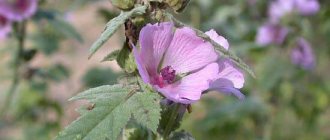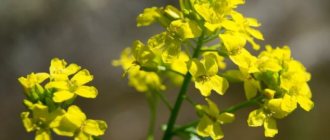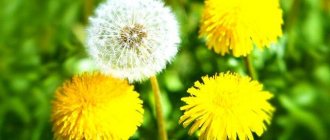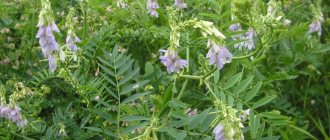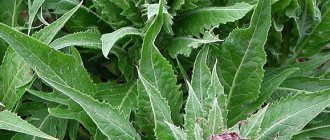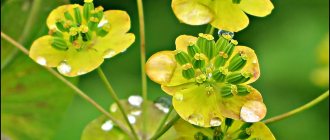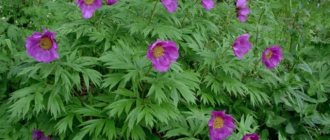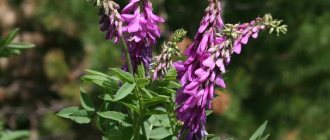Marshmallow has an extensive list of healing properties that are known to people who prefer natural treatment. Marshmallow syrup and root, as well as extracts, decoctions and infusions have long been used to get rid of various diseases. The benefits of this plant are generally difficult to overestimate. The method of preparation and type of medicine must be selected in accordance with the disease and the desired healing effect. Various recipes for use will be discussed in this article.
Description of the plant
The marshmallow plant is a member of the extensive malvaceae family. Herbal medicine uses grass, flowers, and the underground part of the plant – the root. Popularly, marshmallow is also known as marshmallow or mallow. Sometimes it is also called wild rose.
Althea is classified as herbaceous, due to the abundance of greenery on its ground part. But, as for grass, its stem is too tall, powerful and strong. Young plants have 1 stem, while older representatives of this species can have up to 10 stems growing from 1 rhizome. The average height of an adult plant is about 1.5 meters, sometimes marshmallow grows up to 2 meters.
Marshmallow has been used in herbal medicine for a very long time. Healers from Ancient Greece respectfully called it “herb for any disease.” Hippocrates wrote about him in his works. Today, despite the abundance of therapeutic agents and methods, marshmallow-based medicines are still popular. This is understandable - they are effective and do not harm the body.
Description of marshmallow
In forest-steppe and steppe, marshmallow grows in bushes on the banks of water bodies; the thickets can be sparse or grouped. This plant loves excess moisture and a temperate climate, high location of groundwater.
In wild conditions, bushes grow up to a meter, and under particularly favorable conditions up to 1.5 meters. In the garden, the height of the wild poppy reaches the height of a person.
The main woody root is white, thick, short, there are a lot of lateral roots. The aboveground stems are cylindrical at the bottom, with a structure close to wood.
A young plant has one, an old one can have up to ten (one main one and several thinner ones). The gray-green stems that form the bush from the root are covered with dense short hairs.
Description of the shape of the gray-green leaves of medicinal marshmallow:
- the lower (temporary) round ones, with a heart-shaped base, five lobes, soft to the touch, die off before flowering;
- medium cuttings of the same shape, with three or five lobes, covered with short fluff;
- the upper ones are oblong, solid, covered with thick down.
The flowers are located in the axils of the upper and middle leaves. The color is white (less often pink), the pedicels are short, there are five wide ovoid petals with a diameter of 2 cm, narrowed at the base.
Five leaves of a bowl in the shape of an egg, pointed, covered with hairs. The undercup has up to 12 short petals. Marshmallow flowering begins in June and continues until September.
Flat fruits 7-10 mm, wrapped in a fluffy cup, ripen in autumn. The smooth brown seeds have a disk shape with a diameter of up to 2-2.5 mm.
Varieties of marshmallow
There are approximately 17 varieties of wild poppy in nature, the most common are:
- Armenian;
- brussoneciophyllum;
- hemp;
- coarse-haired (rough);
- Ludwig.
- Armenian marshmallow
Wild species are found in the Azov region, Crimea, and the Caucasus. It grows in small groups (less often singly) in places with high humidity (meadows, bushes, shell rocks, clearings, gardens).
The stem is straight and tall, the leaves are divided into 5 oval lobes with sharp teeth. Flowers with five petals are grouped into racemes. The fruit consists of a large number of seeds located around the circumference of the ring.
The root consists of:
- starch (up to 37%);
- mucus (up to 35%);
- pectins (up to 16%);
- sugar (up to 8%);
- betaine, asparagine, oil.
In folk medicine it is used to treat diseases of the intestines, stomach, kidneys, and respiratory tract. Water infusion and extract help get rid of eczema.
- Marshmallow brussonecielifolia
It grows on the Baer hillocks, in the middle part of Asia, in the Volga delta, and at the seaside. Height up to 2 meters. The plant has a straight, pubescent stem, large, long leaves, dissected into 5 oval lobes with large denticles.
The largest serrated-lobed middle lobe. The sides are soldered and directed upwards. The upper leaves are three or five segmented, the lobes are narrow, bent back. All foliage is covered with fine fluff; the stipules fall off during flowering.
Inflorescences in the form of panicles (tassels). The flower stalks are short (except for single flowers, which are located in the axils of the foliage). There are up to 9 dissected petals in the subcup.
The oblong, oval lobes of the bowl are pulled together at the apex. The corolla is small and pink. The petals are oblong, contracted at the base. The fruits consist of 15-18 pubescent brown seeds with a length of up to 3 mm.
- Hemp marshmallow
Bushes of this species grow up to 2 meters, geographical location: South, Central Europe, Near, Middle East, Central Asia.
Grows in nature:
- on the edges of deciduous (sometimes pine) forests;
- in bushes growing on rocky, chalk, limestone slopes;
- in the meadows, in the steppes;
- in vacant lots, pastures;
- parks, on roads.
The bushes are branched, with a fluffy, straight main stem. The leaves are up to 6 cm long on cuttings, cut into 3 parts, tapering at the base. The lower leaves are similar to hemp foliage, cut into 5 segments, the lobes are oval.
The flowers are solitary, the length of the legs is up to 20 cm. The subcups are made of 7-9 petals, dissected at the top, fused at the base. The bowl is oval, with lobes elongated at the top. Red corolla, 2-3 times the size of the calyx. The fruits contain 12-16 bare brown seeds.
The root part contains iron, manganese, potassium, calcium, the foliage is rich in rubber-like substances, essential oils, carotene, and ascorbic acid.
- Althaea rough
The height does not exceed 50 cm, the stem covered with hard fluff is straight, cylindrical, single from the base (in a young plant) or branched. Grows in North Africa, in the south, in the center of Europe, in Western and Central Asia. Loves rocky slopes with clay soil, bushes, not too dense forests, meadows.
Leaflets with cuttings of varying lengths (depending on location):
- at the roots there are plates with five (seven) wide, round lobes;
- in the middle of the bush there is platinum with three or five oval lobes;
- at the top there is a platinum with three oblong, narrow blades.
The flowers are solitary, with a long stalk. The subcups have eight pointed petals, the lobes of the cup are one-third fused, the corolla is violet or purple. The fruits contain 12-18 brown, narrow, bare seeds.
- Althea Ludwig
It grows in Western and Central Asia, near the Mediterranean Sea, and in Africa. Maximum height 35 cm, several bluish-green cylindrical stems. Leaves with long stalks, thick plates, five wedge-shaped lobes. The fruits contain 8-10 bare, brown, smooth seeds.
Uses of wild poppy
The main area of application of marshmallow is determined by the pharmacological properties of the mucous substance contained in the root system. It relieves pain, relieves inflammation, coats the surface of the skin (mucous membrane), and promotes expectoration.
In combination with other medications, their removal from the body is slowed down and the effectiveness of the effect increases.
External use:
- poultices for inflammation of the facial skin;
- applications for fungal diseases;
- treatment of burns and wounds;
- rinsing the mucous membranes of the throat, nose, mouth when treating colds, sore throats;
- applications for periodontal disease, inflammation in the mouth.
Indications for use
Preparations based on marshmallow have a wide range of beneficial properties. You can prepare medicines exclusively from this plant, or mix it with other phytocomponents.
The above-ground part contains a large amount of starch, as well as polysaccharides, the roots are rich in l-asparagine with sucrose, pectin, unique fatty oils, betaine with carotene, phytosterols, various minerals, and also uronic acids with mineral salts.
Herbal remedies based on marshmallow effectively eliminate the following diseases and pathologies:
- inflammation of the nasopharynx, throat, oral cavity - rinses are made based on an aqueous infusion of the root. You can also dilute an alcohol tincture on the roots of marshmallow with water and use it in the same way,
- diseases of the upper respiratory tract - rinsing with an infusion of marshmallow root, ingesting marshmallow root extract,
- gastrointestinal diseases, including ulcers, gastritis and dysentery - taking syrup or water infusion of marshmallow root,
- diarrhea - a decoction of marshmallow root acts as a fixative and also a nutritious agent,
- skin pathologies, in particular eczema, dermatitis, including allergic, as well as psoriasis - lotions based on an aqueous infusion or decoction of marshmallow roots and leaves,
- candidiasis in the acute or chronic stage - douching with an aqueous infusion of marshmallow root,
- adenoma and prostatitis - taking marshmallow root infusion,
- increased sweating, including from nervous overstrain - an aqueous infusion of marshmallow root is used externally,
- dandruff - rinsing the head with a decoction of marshmallow seeds.
If marshmallow root extract is added to barium powder, it will help make intestinal x-rays more accurate. The relief of the inner surface of the walls will be more clearly visible.
This plant is used independently, as well as together with other herbal remedies. For example, with oregano and coltsfoot in the form of breast collection No. 1, with licorice and elecampane - in breast collection No. 2.
We invite you to watch the video: Althaea officinalis - beneficial properties
Contraindications and side effects
Like any herbal medicine, marshmallow has its own side effects and contraindications. Anyone who decides to be treated with this plant should familiarize themselves with this information.
Due to the high enveloping and mucus-secreting properties of marshmallow root, absorption is reduced, and hence the effectiveness of other drugs taken with it. To avoid this, you need to take medications internally with a break of 2 hours after taking marshmallow root.
If you take marshmallow root and sodium bicarbonate at the same time, the expectorant effect is enhanced, which means the overall effectiveness of treatment increases.
If hives, swelling or other manifestations of allergies appear, taking the herbal remedy based on marshmallow root should be stopped. It is especially important to monitor your body for those who are prone to allergies. However, such a reaction of the body to this drug is observed quite rarely.
Since the effect of taking marshmallow during pregnancy has not been well studied, you should consult your obstetrician before taking it.
Marshmallow root is not used to treat children under 3 years of age and should not be used by nursing women. It is also undesirable for children and pregnant women to take alcoholic tincture of marshmallow.
What are the beneficial properties of marshmallow?
The valuable biochemical composition of the herb determines its beneficial properties .
- Polymer natural mucus, starch, and other colloidal components have enveloping, protective surface properties. When exposed to the acidic environment of the stomach, the properties are enhanced.
- Colloidal substances have an antitussive and expectorant effect.
- Mucus accumulates viral and bacterial toxins in the protective layer they create. As a result, the inflammatory process is relieved and intoxication of the body is reduced.
- Polysaccharides improve the condition of the immune system and increase the activity of phagocytes.
- It has wound-healing and analgesic properties.
Althaea officinalis: methods of use in medicine, recipes
There are different ways to create medicines from marshmallow.
Based on it, decoctions, water and alcohol infusions, tinctures, and extracts are made. Marshmallow syrup is no less popular. Those who suffer from sore throat or inflammation of the oral cavity can effectively help to recover from chewing fresh marshmallow roots.
Marshmallow syrup
Marshmallow-based syrup can be purchased at a pharmacy or made yourself. The method of preparing it is not complicated. Take 2 grams (about 1 teaspoon) of crushed (chopped) marshmallow root and pour it into a clean, pre-prepared container that looks like a filter. Next, wine alcohol and water are mixed in a ratio of 1:45 and poured into a container with phyto-raw materials. Everything that flows to the bottom is collected and then poured through the root again. This manipulation must be repeated for an hour. The end result is about 37 grams of liquid. Pour 63 grams of sugar into it, then heat everything over low heat until it dissolves.
If desired, you can add a few drops of anise oil to the syrup. Thus, an effective mixture is obtained that helps get rid of cough and bronchitis. Children are given 1 teaspoon diluted in half a glass of water, adults take 2 teaspoons diluted or pure. You need to drink syrup 4-5 times a day.
Marshmallow infusions
To prepare an infusion of marshmallow at home, you should take 6.5 grams of the crushed root of this plant and then pour 125 grams of cold water over it. Everything is infused for 1 hour and filtered. You should take 1 tablespoon of this herbal remedy for the treatment of adenoma, as well as prostatitis, every 2 hours.
To treat various diseases of the respiratory system, as well as the genitourinary system, an alcoholic infusion of marshmallow is used. It is quite possible to prepare it at home. You need to take 20 grams of pre-crushed root of this plant and pour 500 grams of vodka or alcohol. After this, the container is closed, shaken and placed in a dark place. After 10 days, the liquid must be filtered. It does not lose its beneficial properties for 1 year. This herbal medicine is taken 10-15 drops 3 times a day. Must be consumed before meals. It is advisable to dilute the drops with water so that they do not burn the oral cavity and esophagus.
For external use, marshmallow infusion is prepared according to a different recipe. Take 3 teaspoons of crushed plant root and pour 1 glass of cool, pre-boiled water. You need to leave everything for 8 hours, then strain. The infusion is used as a lotion. It helps get rid of trigeminal neuralgia, allergic conjunctivitis and myositis.
For sweating and diaper rash, as well as dermatitis, you need to make the following infusion of marshmallow root: crushed roots are poured with water at room temperature in a ratio of 1:20.
Everything is infused for an hour, then carefully filtered through cheesecloth. Then gauze or soft cloth folded in several layers is moistened in this liquid and applied to the “problem” areas of the skin. When preparing medicines based on marshmallow root, you should never boil or boil them. Due to the high starch content, the liquid will turn into a kind of paste.
Infusion of marshmallow leaves and flowers
Not only the underground, but also the above-ground part of the plant has found its application in herbal medicine.
An infusion of marshmallow flowers is prepared as follows: take 1 teaspoon of flowers and place it in a container, then pour 250 grams of boiling water into it. You need to let the mixture brew for 2 hours, then strain. Take this remedy 1 tablespoon three times a day.
An infusion based on marshmallow leaves is made as follows: you need to take 1 tablespoon of crushed or dried leaves, pour 1 glass of boiling water and leave for 1 hour. Then the liquid is filtered and taken 1 tablespoon 3-4 times a day.
Marshmallow flower tea
Marshmallow flowers can serve as the basis for a tasty and healthy drink - tea. It is quite easy to prepare. You need to pour 2 tablespoons of the herbal component into 1 liter of boiling water and, wrapping it up, let it brew for 10-15 minutes. Then the liquid is filtered and honey is added to taste. This tea is good to drink for colds, acute respiratory infections or flu, as well as for severe coughs 2-3 times a day, regardless of meals.
Marshmallow decoction
Dandruff is a problem that is familiar to many first-hand.
A good folk remedy to help remove it is rinsing your head with a decoction of marshmallow seeds. You need to take phyto-raw materials and water in a ratio of 1:20, heat everything in a water bath and hold for 1 hour. Then the liquid must be filtered and diluted with water to make half a liter. Rinse your hair with the resulting product after washing your hair. For greater effect, you can not dilute the resulting decoction of marshmallow seeds with water, but rub it twice a day into the scalp without rinsing. Depending on the desired effect, to prepare herbal remedies, you can mix marshmallow with coltsfoot, mint, lemon balm, thyme and other herbs.
Collection and preparation of medicinal raw materials
Marshmallows, like any other plants, need to be collected for subsequent harvesting in environmentally friendly places. Plants growing near highways, factories, as well as in urban areas - in parks, squares and courtyards of residential buildings are not suitable.
There are different harvesting rules for marshmallow roots, flowers and leaves. The collected raw materials should not be rotten, eaten away by insects, damaged or too contaminated, as this will complicate or make it impossible to harvest them, as well as prepare medicines from them.
Harvesting of roots is carried out in the first half of autumn, until the end of October, when the above-ground part of the plant has already died. You can also collect it in the spring, while the marshmallow has not yet begun to “come to life” and grow. Plants 2-3 years old are ideal for this purpose. You will have to remove the rhizomes from the ground manually, acting carefully. It is necessary to remove excess soil, get rid of the coarsened part of the main root, as well as damaged parts. The roots need to be dried in the fresh air for a couple of days, then the plug should be removed from them. Thick roots are cut into several pieces, and long ones are cut into transverse parts, no more than 30 centimeters in length.
In cases where rhizomes that have not been cleared of plugs are needed, after digging them up, they should be quickly washed under running, cool water. It is strictly forbidden to soak the raw materials, since the valuable mucus will dissolve and the therapeutic effect of medicines prepared from such roots will disappear or be greatly reduced.
Marshmallow roots are dried naturally or in special dryers. The main thing is that the temperature does not exceed 50-60 degrees.
Marshmallow grass is harvested by hand picking or mowing. This should be done in the summer, within a month from the moment the marshmallow blooms. Dried, yellowed or brown leaves should be removed from the resulting phyto-raw materials. It is recommended to sort out the grass, removing foreign impurities. They could have gotten in during the process of mowing plants. The leaves are washed under running water and dried in a ventilated, dark place. You cannot use special dryers for this.
Marshmallow flowers are collected during the flowering period of the plant.
Fully blossomed, undamaged buds are suitable. They also need to be washed and dried in conditions similar to leaves. In order not to destroy this medicinal plant, during its collection it is worth leaving large specimens for subsequent seed ripening. It is also good to shake off its seeds when digging marshmallows into the holes formed at the site of the plant .
Medicinal raw materials are very susceptible to moisture and strong odors, so they must be stored in a well-ventilated area, away from sources of moisture or strong-smelling products or substances. Dried marshmallow roots retain all their beneficial qualities for 3 years, and herbs and flowers, like seeds, can last up to 5 years.
Features of cultivation
Althaea officinalis is a very unpretentious plant. Prefers light, fertilized, loose soils with shallow groundwater (2-3 m). When preparing the site for planting, organic matter and mineral fertilizers are added. For 1 sq. m take 3-4 kg of rotted manure and 45-60 g of phosphorus-potassium fertilizers.
In the spring and during the flowering period, marshmallow is fed with nitrogen or complex fertilizers at the rate of 3 g per 1 sq. m. m. Marshmallow is propagated by seeds and by dividing the bush (cutting the rhizome into pieces). Before soaking, remove the pericarp of the fruit, selecting the seeds from it. Keep in mind that seed germination is low (about 70%).
It can be increased by soaking the seeds in a solution with the addition of succinic acid and epin (kept for 24 hours at a temperature of 25°C). Then they are dried to a free-flowing state. Seeds for propagation can be collected from a wild plant or bought in a store.
They need to be sown immediately in a permanent place in holes or rows to a depth of 2 cm. If you are going to grow marshmallow as a perennial crop, then leave 60-70 cm between plants, since it takes up a lot of space. Under favorable conditions, seedlings appear on the 8-10th day.
Pieces of rhizome with a bud are planted according to the same scheme (leaving about 70 cm of free space per plant). When planting, make sure that the buds on the rhizome remain on the surface: if you deepen it too much, the bud may rot and the plant will die.
Care
Althaea officinalis needs care, which consists of loosening the soil, thinning out seedlings, weeding and regular watering. To keep the soil from compacting and to prevent weeds from growing, mulch the plant using fine limestone gravel as mulch.
This is a convenient material that simultaneously performs the function of mulch and supplies the soil with calcium. In addition, it is very decorative. In autumn, cut off the above-ground part, leaving 15 cm, so that the roots and rhizomes do not rot.
Collection of raw materials
Rules for collecting the roots, flowers and herbs of marshmallow vary. The roots are harvested in the first half of the autumn season, usually until the end of October. At this time, the plant is already going dormant, and its above-ground part is dying off.
An alternative time for harvesting is spring: until the plant begins to grow and is at rest. It is best to use a 2-3 year old plant. Young, non-lignified lateral adventitious and tap roots are used as medicinal raw materials.
Harvesting roots
The rhizome is not used. It is not easy to extract marshmallow from the ground. Using a shovel, cut out a piece of soil measuring 25x25 cm, one bayonet deep or a little more. Next, pull out the lump and, beating it on a hard surface, shake off the soil. Cut off the above-ground part of the plant and quickly wash the rhizome and roots with running cold water.
After washing, cut off all the roots: this will be the collected raw material. If further cultivation of the crop is necessary, the main, lignified root is left, and the rhizome is dug into the soil.
The cut roots are washed again with cold water (without soaking in any case, as this will wash out the valuable mucus and reduce the value of the raw material) and dry in the fresh air for 2 days.
After this, thick pieces of root are cut into several pieces lengthwise and crosswise (the size of the pieces is no more than 30 cm). Marshmallow roots are dried in dry, warm rooms, without access to light, or in electric dryers (at a temperature of no more than 50 ° C).
Completely dried roots should break easily to form a fine cloud of white “dust” (starch and polysaccharides). The marshmallow grass is mowed or picked by hand within a month from the moment the plant blooms.
Expert opinion
Ancient healers considered marshmallow to be priceless. Actually, its name comes from the ancient Greek word “alcea”, which means “healing all diseases”.
The benefits of natural medicines based on marshmallow are recognized even by ardent adherents of pharmacological treatment methods. Doctors who prescribe certain medications to their patients often recommend preparations with marshmallow in addition to them.
Doctors who recommend natural treatment consider medicines from the root, flowers or leaves of marshmallow to be among the most effective. Doctor Popov Petr Aleksandrovich says that marshmallow is a wonderful remedy for curing various diseases of the upper respiratory tract. He advises not only using infusions from this plant, but also chewing its roots raw. According to him, the cough, in this case, becomes soft, sputum is easily cleared, and the lungs are cleared.
Many modern pulmonologists recommend an infusion of marshmallow roots as an auxiliary medicine for pneumonia, pneumonia and pleurisy. Doctors also advise patients with tuberculosis to take an aqueous infusion of the root of this plant. This herbal remedy alleviates the general condition and helps cleanse the lungs.
Video with comments by Popov Peter
History of marshmallow
The healing properties of this plant have been known since the 15th century BC. e. The name “Marshmallow” comes from the Greek word (alcea) - “one that heals.” You can read about its use as a medicine in the works of the ancient Greek thinkers Theophrastus, Galen, Dioscorides and Hippocrates.
Hesiodos believed that in ancient Greece, Althaea officinalis was a popular plant among both the nobility and the poor. Since marshmallow often grew near settlements and had no toxic properties, almost all diseases were treated with it.
Knowledge about this plant was not lost in the Middle Ages. Outstanding naturalists of that time (Avicenna, Albertus Magnus, Paracelsus, Mattioli, Adam Lonitseri and Simon Sirensky) described the methods of using marshmallow in healing.
Marshmallow root was part of complex ointments that no self-respecting doctor could do without. Althaea officinalis was necessarily grown in the monastery gardens of the Benedictine Order. In 1611, the herbal book (Zielnik) of the Polish physician and botanist Simon Sirensky was published.
He recommended infusing marshmallow roots with wine and using this method to treat stomach pain due to dysentery, and boiling licorice root in milk for advanced bronchitis and dry cough. The experience of using marshmallow as a medicine came to Russia with the help of foreign doctors.
Since 1778, the roots of marshmallow were included in all Russian, and over time, Russian pharmacopoeias. Thus, the ancient remedy has remained in demand and recognized by official medicine for almost two and a half thousand years.
